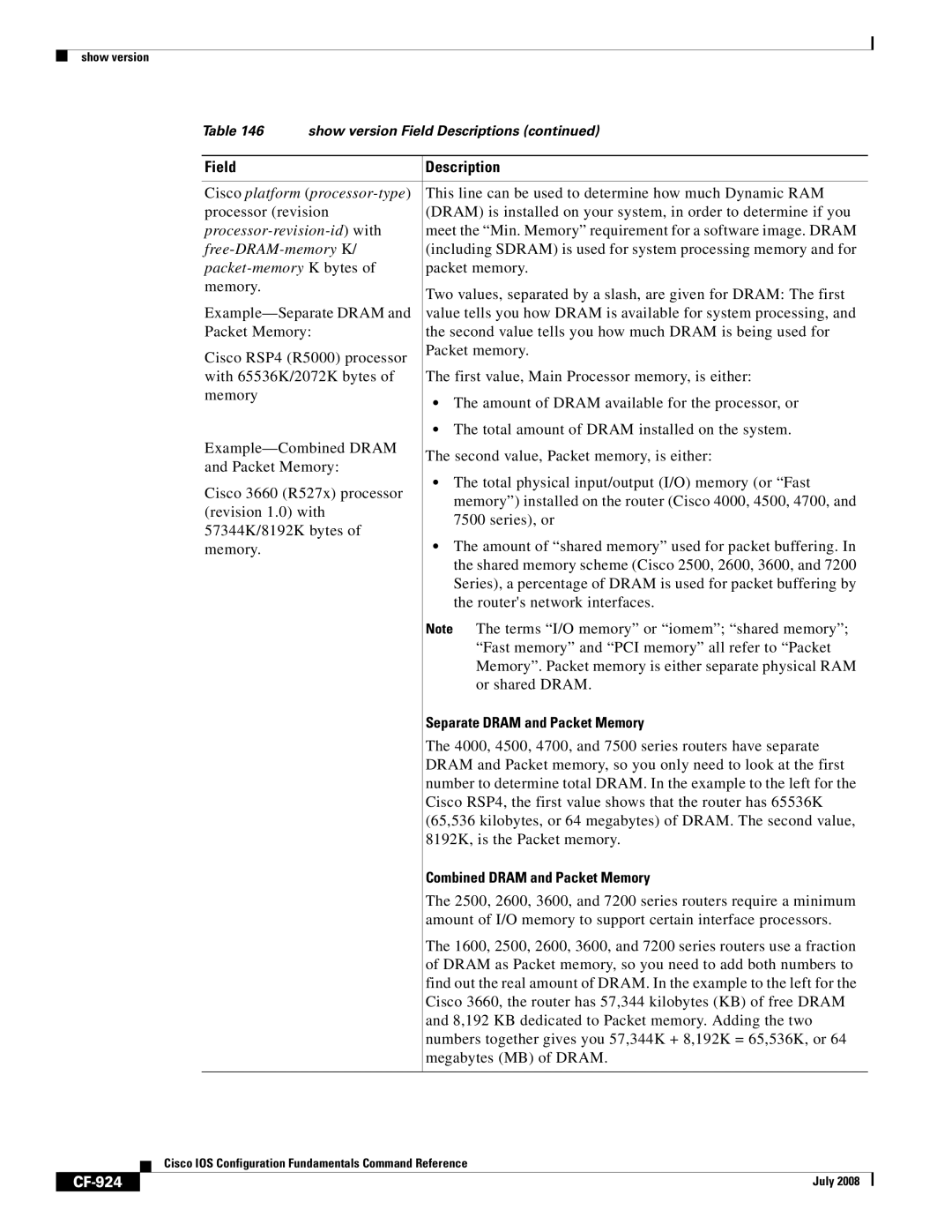
show version
Table 146 show version Field Descriptions (continued)
Field | Description | |
|
| |
Cisco platform | This line can be used to determine how much Dynamic RAM | |
processor (revision | (DRAM) is installed on your system, in order to determine if you | |
meet the “Min. Memory” requirement for a software image. DRAM | ||
(including SDRAM) is used for system processing memory and for | ||
| packet memory. | |
memory. | Two values, separated by a slash, are given for DRAM: The first | |
| ||
value tells you how DRAM is available for system processing, and | ||
Packet Memory: | the second value tells you how much DRAM is being used for | |
Cisco RSP4 (R5000) processor | Packet memory. | |
| ||
with 65536K/2072K bytes of | The first value, Main Processor memory, is either: | |
memory | • The amount of DRAM available for the processor, or | |
| ||
| • The total amount of DRAM installed on the system. | |
The second value, Packet memory, is either: | ||
and Packet Memory: | ||
• The total physical input/output (I/O) memory (or “Fast | ||
Cisco 3660 (R527x) processor | ||
memory”) installed on the router (Cisco 4000, 4500, 4700, and | ||
(revision 1.0) with | ||
7500 series), or | ||
57344K/8192K bytes of | ||
• The amount of “shared memory” used for packet buffering. In | ||
memory. | ||
| the shared memory scheme (Cisco 2500, 2600, 3600, and 7200 | |
| Series), a percentage of DRAM is used for packet buffering by | |
| the router's network interfaces. | |
| Note The terms “I/O memory” or “iomem”; “shared memory”; | |
| “Fast memory” and “PCI memory” all refer to “Packet | |
| Memory”. Packet memory is either separate physical RAM | |
| or shared DRAM. | |
| Separate DRAM and Packet Memory | |
| The 4000, 4500, 4700, and 7500 series routers have separate | |
| DRAM and Packet memory, so you only need to look at the first | |
| number to determine total DRAM. In the example to the left for the | |
| Cisco RSP4, the first value shows that the router has 65536K | |
| (65,536 kilobytes, or 64 megabytes) of DRAM. The second value, | |
| 8192K, is the Packet memory. | |
| Combined DRAM and Packet Memory | |
| The 2500, 2600, 3600, and 7200 series routers require a minimum | |
| amount of I/O memory to support certain interface processors. | |
| The 1600, 2500, 2600, 3600, and 7200 series routers use a fraction | |
| of DRAM as Packet memory, so you need to add both numbers to | |
| find out the real amount of DRAM. In the example to the left for the | |
| Cisco 3660, the router has 57,344 kilobytes (KB) of free DRAM | |
| and 8,192 KB dedicated to Packet memory. Adding the two | |
| numbers together gives you 57,344K + 8,192K = 65,536K, or 64 | |
| megabytes (MB) of DRAM. | |
|
|
| Cisco IOS Configuration Fundamentals Command Reference |
| July 2008 |
